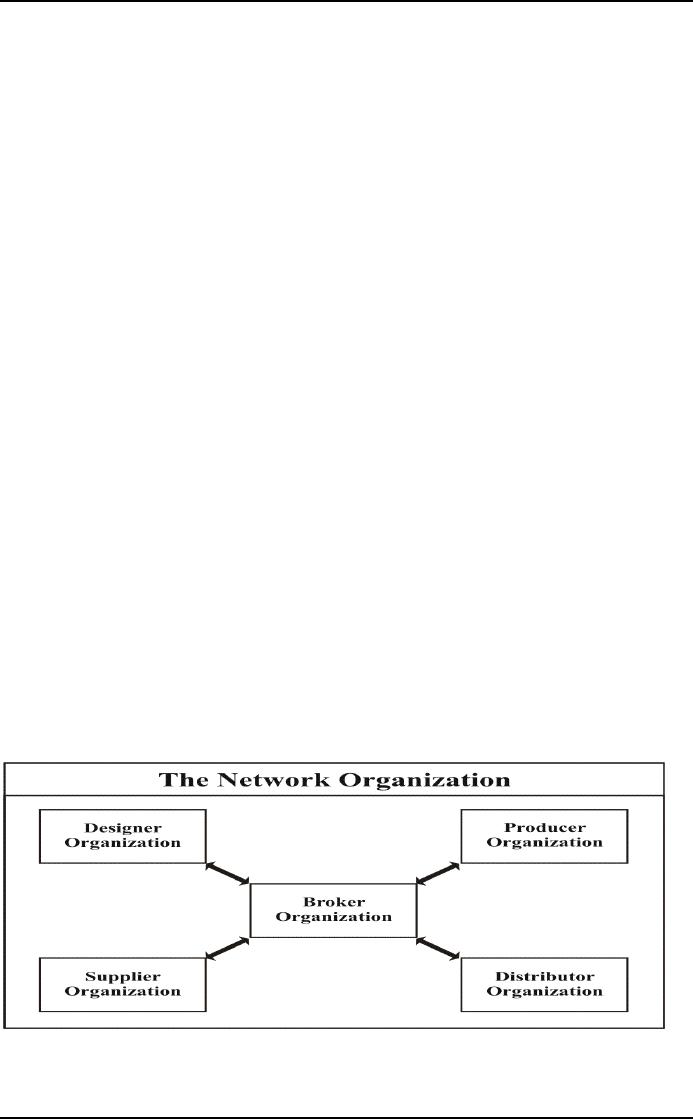 |

Organization
Development MGMT
628
VU
Lesson
35
Restructuring
Organizations
Network-Based
Structures:
A
network-based structure manages the
diverse, complex, and
dynamic relationships among
multiple
organizations
or unit5, each specializing in a
particular business junction or task.
Sonic contusion over the
definition
of a network has been clarified
recently by a typology describing
four basic types of
networks.
·
An
internal market network
exists when a single organization
establishes each subunit as an
independent
profit center that is allowed to
buy and sell services
and resources from each
other as
well
as from the external market. Asea
Brown Boveri's (ABB) fifty
worldwide businesses consist
of
twelve
hundred companies organized
into forty-five hundred
profit centers that conduct
business
with
each other.
·
A vertical
market network is composed of
multiple organizations linked to a focal
organization that
coordinates
the movement of resources from raw
materials to end consumer.
Nike, for example,
has
its shoes manufactured in
different plants and then
organizes their distribution
through retail
outlets.
·
An
inter-market network represents alliances
among a variety of organizations in
different markets
and
is exemplified by the Japanese keiretsu
and the Korean
chaebol.
·
An
opportunity network is the most
advanced form of network
structure. It is a temporary
constellation
of
organizations
brought
together
to
pursue
a
single
purpose.
Once accomplished, the network
disbands.
These
types of networks can be distinguished
from one another in terms of whether they
are single or
multiple
organizations, single or multiple
industry, and stable or temporary.
For example, an internal
market
network
is a stable, single-organization, single-industry
structure; an opportunity network is a
temporary,
multiple-organization
structure that can span
several different
industries.
As
shown in Figure 46, the network
structure redraws organizational
boundaries and links
separate business
units
to facilitate task interaction. The
essence of networks is the relationships among
organizations that
perform
different aspects of work. In this
way, organizations do the things that
they do well; for example,
manufacturing
expertise is applied to production, and
logistical expertise is applied to distribution.
Network
organizations
use strategic alliances,
joint ventures, research and
development consortia, licensing
agreements,
and wholly owned subsidiaries to
design, manufacture, and
market advanced products,
enter
new
international markets, and develop
new technologies.
Network-based
structures are known by a variety of
names, including shamrock
organizations and
virtual,
modular,
or cellular corporations. Less formally, they
have been described as
"pizza" structures,
spider
webs,
starbursts, and cluster
organizations. Companies such as
Apple Computer, Benetton,
Sun
Microsystems,
Liz Claiborne, MCI WorldCom, and Merck
have implemented fairly sophisticated
vertical
market
and inter-market network structures.
Opportunity networks also are
commonplace in the
construction,
fashion, and entertainment industries, as
well as in the public
sector.
Figure
46: The Network
Organization
Network
structures typically have the
following characteristics.

Organization
Development MGMT
628
VU
·
Vertical
desegregation. This
refers to the breaking up of the organization's
business functions, such
as
production, marketing, and distribution,
into separate organizations
performing specialized work.
In
the
film industry, for example,
separate organizations providing
transportation, cinematography,
special
effects,
set design, music, actors,
and catering all work
together under a broker organization, the
studio.
The
particular organizations making up the opportunity
network represent au important
factor in
determining
its success.'" More recently,
disintermediation, or the replacement of whole
steps in the
value
chain by information technology,
specifically the Internet, has fueled the
development and
numbers
of network structures.
·
Brokers.
Networks
often arc' managed by broker
organizations that locate
and assemble member
organizations.
The broker may play a
central role and subcontract
for needed products or services, or
it
may
specialize in linking equal
partners into a network. In the
construction industry, the general
contractor
typically assembles and
manages drywall, mechanical, electrical,
plumbing, and other
specialties
to erect a building.
·
Coordinating
mechanisms. Network
organizations generally are
not controlled by
hierarchical
arrangements
or plans. Rather, coordination of the
work in a network falls into
three categories:
informal
relationships, contracts, and
market mechanism. First, coordination
patterns can depend
heavily
on interpersonal relationships among individuals
who have a well-developed
partnership.
Conflicts
are resolved through reciprocity;
network members recognize
that each likely will
have to
compromise
at some point. Trust is
built anti nurtured over
time by these reciprocal
arrangements.
Second,
coordination can be achieved
through formal contracts,
such as ownership control,
licensing
arrangements,
or purchase agreements. Finally,
market mechanisms, such as
spot payments,
performance
accountability, and information systems,
ensure that all parties
are aware of each
others'
activities.
Network
structures have a number
of advantages and
disadvantages, as
shown
in
Table 16. They are highly
flexible and adaptable to
changing conditions. The ability to
form partnerships
with
different organizations permits the
creation of a "best-of-the-best" company to
exploit opportunities,
often
global in nature. They enable
each member to exploit its
distinctive competence. They
can
accumulate
and apply sufficient resources
and expertise to large, complex
tasks that single
organizations
cannot
perform. Perhaps most
important, network organizations
can have synergistic effects
whereby
members
build on each other's strengths
and competencies, creating a
whole that exceeds the sum
of its
parts.
Table
16
Advantages,
Disadvantages and Contingencies of the
Network-Based Form
Advantages
Disadvantages
Contingencies
·
Managing
lateral relations
·
Highly
complex and
·
Enables
highly flexible
and
adaptive response to
across
autonomous
uncertain
environments
·
Organizations
of all sizes
organizations
is difficult
dynamic
environments
·
Motivating
members to
·
Creates
a "best-of-the-
·
Goals
of organizational
best"
organization to
relinquish
autonomy to
specialization
and
focus
resources
on
join
the network is
innovation
troublesome
customer
and market
·
Highly
uncertain
·
Sustaining
membership
needs
technologies
·
and
benefits can be
Enables
each
·
Worldwide
operations
problematic
organization
to leverage a
·
May
give partners access
distinctive
competency
·
to
proprietary
Permits
rapid global
knowledge/technology
expansion
·
Can
produce synergistic
results
The
major problems with network
organizations are in managing
such complex structures. Galbraith
and
Kazanjian
describe network structures as
matrix organizations extending beyond the
boundaries of single
firms
but lacking the ability to appeal to a
higher authority to resolve conflicts.
Thus, matrix skills
of
managing
lateral relations across organizational
boundaries arc critical to administering
network structures.
Most
organizations, because they are
managed hierarchically, can be expected
to have difficulties
managing
lateral
relations. Other disadvantages of
network organizations include the
difficulties of motivating

Organization
Development MGMT
628
VU
organizations
to join such structures and
of sustaining commitment over time.
Potential members may
not
want
to give up their autonomy to link with
other organizations and,
once linked, they may have
problems
sustaining
the benefits of joining together. This is
especially true if time network
consists of organizations
that
are not the "best of breed."
Finally, joining a network
may expose the organization's
proprietary
knowledge
and skills to others.
As
shown in Table 16, network
organizations are best
suited to highly complex and uncertain
environments
where
multiple competencies and
flexible responses are
needed. They seem to apply to
organizations of all
sizes,
and they deal with complex
tasks or problems involving
high interdependencies across
organizations.
Network
structures fit with goals
that emphasize organization
specialization and
innovation.
Downsizing:
Downsizing
refers to interventions aimed at
reducing the site of the organization. This
typically is
accomplished
by decreasing the number of employees
through layoffs, attrition, redeployment, or
early
retirement
or by reducing the number of organizational units or
managerial levels through
divestiture,
outsourcing,
reorganization, or delayering. In practice, downsizing
generally involves layoffs where a
certain
number
or class of organization members is no longer
employed by the organizations.
Although
traditionally
associated with lower-level workers,
downsizing increasingly has claimed the
jobs of staff
specialists,
middle managers, and senior
executives.
An
important consequence of downsizing has
been the rise of the contingent
workforce. These less
expensive
temporary or permanent part-time workers
often are hired by the
organizations that just laid
elf
thousands
of employees. A study by the American
Management Association found that
nearly a third of the
720
firms in the sample had rehired recently
terminated employees as independent contractors
or
consultants
because time downsizings had
not been matched by an appropriate
reduction in or redesign of
the
workload. Overall cost
reduction was achieved by
replacing expensive permanent
workers with a
contingent
workforce.
Downsizing
is generally a response to at least
four major conditions. First, it is associated
increasingly with
mergers
and acquisitions. One in nine
job cuts during 1998
were the result of the integration of
two
organizations;
second, it can result from
organization decline caused by loss of
revenues and market
share
and
b1 technological and industrial change.
In southern California, an economy
traditionally dependent on
the
defense industry, more than
one hundred thousand jobs
have been lost to relocation or
elimination as
that
industry has contracted and
consolidated. Third, downsizing can
occur when organizations implement
one
of the new organizational structures
described above. For
example, creation of network-
based
structures
often involves outsourcing work to
other firms that is not
essential to the organization's
core
competence.
Fourth, downsizing can result
from beliefs and social
pressures that smaller are
better. In the
United
States; there is strong
conviction that organizations should be
leaner and more flexible.
Hamel and
Prahalad
warned, however, that organizations
must be careful that downsizing is
not a symptom,
"corporate
anorexia." Organizations may downsize
for their own sake
and not think about future
growth.
They
may lose key employees
who are necessary for
future success, cutting into
the organization's core
competencies
and leaving a legacy of mistrust
among members. In such
situations, it is questionable
whether
downsizing is developmental as defined in
OD.
Application
Stages:
Successful
downsizing interventions tend to proceed
by the following steps:
1.
Clarify
the organization's strategy. As a
first step, organization leaders
specify corporate strategy
arid
communicate clearly how downsizing
relates to it. They seek to
inform members that
downsizing
is not a goal h itself, hut a
restructuring process for achieving
strategic' objectives.
Leaders
need to provide visible and
consistent support throughout the
process. They can
provide
opportunities
for members to voice their
concerns, ask questions, and
obtain counseling if
necessary.
2.
Assess
downsizing options and make relevant
choices. Once
corporate strategy is clear, the
full
range of downsizing options can he
identified and assessed.
Table 17 describes three
primary
downsizing
methods: workforce reduction, organization
redesign, and systemic
change. A specific
downsizing
strategy may Use elements of
all three approaches.
Workforce reduction is aimed
at
reducing
the number of employees, usually in a relatively short
timeframe. It can include
attrition,
retirement
incentives, outplacement services,
and layoffs. Organization redesign attempt
to
restructure
the firm to prepare it for the
next stage of growth. This is a
medium term approach
that
can
be accomplished by merging organizational units,
eliminating management layers,
and
redesigning
tasks. Systemic change is a longer-term
option aimed at changing the culture
and
strategic
orientation of the organization. It can
involve interventions that alter the
responsibilities

Organization
Development MGMT
628
VU
and
work behaviors of everyone in the
organization and that promote
continual improvement as a
way
of life in the firm.
Case,
a manufacturer of heavy construction equipment,
used a variety of methods to
downsize,
including
eliminating money-losing product lines;
narrowing the breadth of remaining
product
lines;
bringing customers to the company
headquarters to get their
opinions of new product
design
(which
surprisingly resulted in maintaining, rather than
changing, certain preferred features,
thus
holding
down redesign costs);
shifting production to outside
vendors, restructuring debt; amid
spinning
off most of its 250
stores. Eventually, these
changes led to closing five
plants and to
payroll
reductions of almost 35 percent.
The number of jobs lost would
have been much
greater,
however,
if Case had not implemented a variety of
downsizing methods.
Unfortunately,
organizations often choose
obvious solutions for downsizing, such as
layoffs,
because
they can be implemented quickly. This action
produces a climate of fear
and defensiveness
as
members focus on identifying
who will be separated from
the organization. Examining a broad
range
of options and considering the entire
organization rather than only certain
areas can help
allay
tears favoritism and
polities are the bases for
downsizing decisions. Moreover,
participation of
organization
members in such decisions
can have positive benefits.
It can create a sense of
urgency
for
identifying and implementing options to
downsizing other than layoffs.
Participation can
provide
members with a clearer understanding of
how downsizing will proceed
and can increase
the
likelihood that whatever
choices are made are
perceived as reasonable and
fair.
3.
Implement
the changes. This
stage involves implementing methods for
reducing the size oh
time
organization. Several practices
characterize successful implementation. First,
downsizing is
best
controlled from the top
down. Many difficult
decisions are required, and a broad
perspective
helps
to overcome people's natural instincts to
protect their enterprise or
function. Second,
identify
arid target specific areas of
inefficiency and high cost.
The morale of the organization
can
be
hurt if areas commonly known to be
redundant are left untouched. Third,
link specific actions
to
the organization's strategy. Organization members
need to be reminded consistently
that
restructuring
activities are part of a plan to improve
the organization's performance.
Finally,
communicate
frequently using a variety of media. This
keeps people informed, lowers
their anxiety
over
the process, and makes it
easier for them to focus on
their work.
Table
17
Three
Downsizing Tactics
Downsizing
Tactic
Characteristics
Examples
Workforce
reduction
Aimed
at headcount reduction
Attrition
Short-term
implementation
Transfer
and outplacement
Fosters
a transition
Retirement
incentives
Buyout
packages
Layoffs
Organization
redesign
Aimed
at organization change
Eliminates
functions
Moderate-term
implementation
Merge
units
Fosters
transition and potentially
Eliminate layers
transformation
Eliminate
products
Redesign
tasks
Systemic
redesign
Aimed
at culture change
Change
responsibility
Long-term
implementation
Involve
all constituents
Fosters
transformation
Foster
continuous improvement
and
innovation
Simplification
Downsizing
a way of life
4.
Address the needs of
survivors and those who
leave. Most
downsizing eventually involves
reduction
in
the size of the workforce, and it is
important to support not only
employees who remain with
the
organization
but also those who
leave. When layoffs occur,
employees are generally
asked to take on
additional
responsibilities and to lean new
jobs, often with little or
no increase in compensation. This
added
workload
can he stressful, arid when combined
with anxiety over past layoffs
and possible future ones,
it
can
lead to what researchers have
labeled time "survivor syndrome." This
syndrome involves a narrow
set
of
self-absorbed and risk-averse
behaviors that can threaten the
organization's survival. Rather
than
working
to ensure the organization's success, survivors
often are preoccupied with
whether additional
layoffs
will occur, with guilt
over receiving pay and
benefits while co workers are struggling
with
termination,
and with the uncertainty of career
advancement.

Organization
Development MGMT
628
VU
Organizations
can address these survivor
concerns with communication processes
that increase the amount
and
frequency of information provided.
Communication should shift from explanations about
who left or
why
to clarification of where the Company is
going, including its visions,
strategies, and goals. The
linkage
between
employees' performance and
strategic success is emphasized so
that remaining members feel they
are
valued. Organizations also can support
survivors through training and
development activities that
prepare
them for the new work they
are being asked to perform.
Senior management can
promote greater
involvement
in decision making, thus
reinforcing the message that people
are important to the
future
success
and growth of the organization.
Given
the negative consequences typically
associated with job loss,
organizations have developed an
array
of
methods to help employees
who have been laid
off. These include outplacement
counseling, personal
and
family counseling, severance
packages, office support for
job searches, relocation services,
and job
retraining.
Each service is intended to assist
employees in their transition to another
work situation.
1.
Follow
through with growth plans. This
final stage of downsizing involves
implementing an
Organization
renewal and growth process.
Failure to move quickly to implement growth
plans is a key
determinate
of ineffective downsizing For example, a
study of 1,020 human
resource directors reported
that
only 44 percent of the companies
that had downsized in the previous
live years shared details of
their
growth
plans with employees; only
34 percent told employees
how they would lit into the
company's new
strategy.
Organizations must ensure that
employees understand the renewal
strategy and their new
roles in
it.
Employees need credible
expectations that, although the organization
has been through a tough
period,
their
renewed efforts can move it
forward.
Results
of Downsizing:
The
empirical research on downsizing is mostly negative. A
review conducted by the National
Research
Council
concluded, "From the research produced
thus tar, downsizing as a strategy
for improvement has
proven
to be, by and large, a
failure." A number of studies base
documented the negative productivity
and
employee
consequences. One survey of 1,005
companies that used downsizing to
reduce costs reported
that
fewer than half of the firms
actually met cost targets.
Moreover, only 22 percent of the
companies
achieved
expected productivity gains,
and consequently about 80 percent of the
firms needed to rehire
some
of the same people that they had
previously terminated. Fewer than 33
percent of the companies
surveyed
reported that profits increased as
much as expected, and only
21 percent achieved
satisfactory
improvements
in shareholder return on investment.
Another survey of 1,142
downsized firms found
that
only
about a third achieved
productivity goals.39 In addition, the
research points to a number of
problems
at
the individual level, including increased
stress and illness, loss of
sell-esteem, reduced trust and
loyalty,
and
marriage and family
disruptions.
Research
on the effects of downsizing on financial performance
also shows negative results.
One study
examined
an array of financial performance
measures, such as return on
sales, assets, and equity,
in 210
companies
that announced layoffs. It found
that increases in financial performance
in the first year
following
the layoff announcements were
not followed by performance improvements
in the next year. In
no
case did a firm's financial
performance after a layoff announcement
match its maximum levels
of
performance
in the year before the announcement.
These results suggest that
layoffs may result in
initial
improvements
iii financial performance,
hut such gains are temporary
and not sustained at even
pre-layoff
levels.
In a sin3ilar study of sixteen firms
that wrote off more
than 10 percent of their net
worth in a live-
year
period, stock prices, which
averaged 16 percent below the
market average before the
layoff
announcements,
increased on the day that the
restructuring was announced but
then began a steady
decline.
Two
years after the layoff announcements, ten
of the sixteen stocks were
trading below the market by
17
percent
to 48 percent, and twelve of the sixteen
were below comparable firms in their
industries by 5 to 45
percent.
These
research findings paint a rather
bleak picture of the success of downsizing.
The results must be
interpreted
cautiously, however, for three
reasons.
First, many
of the survey-oriented studies received
responses from human
resources specialists who
might
have
been naturally inclined to view
downsizing in a negative light.
Second, the
studies of financial performance may
have included a biased sample of firms.
If the companies
selected
for analysis had been
poorly managed, then downsizing
alone would have been
unlikely to improve
financial
performance. There is some empirical
support for this view
because low-performing firms
are
more
likely to engage in downsizing than are
high-performing firms.
Third,
disappointing results may be a
function of the way downsizing was
implemented. A number of
organizations
have posted solid financial returns
following downsizing, such as Florida
Power and Light,
General
Electric, Motorola, Texas instruments,
Boeing, Chrysler, and Hewlett-Packard. A
study of thirty

Organization
Development MGMT
628
VU
downsized
firms in the automobile industry showed
that those companies that
implemented effectively the
process
described above scored significantly
higher on several performance measures
than did firms that
had
no downsizing strategy or that implemented the
steps poorly. Several
studies have suggested that
where
downsizing
programs adopt appropriate CD
interventions or apply strategies similar
to the process outlined
above,
they generate more positive
individual and organizational results.
Thus, the success of downsizing
efforts
may depend as much on how
effectively the intervention is applied as on the
size of the layoffs or
the
amount of delayering.
Reengineering:
The
final restructuring intervention is
reengineering--the fundamental rethinking
and radical redesign
of
business
processes to achieve dramatic
improvements in performance Reengineering
transforms how
organizations
traditionally produce and
deliver goods and services.
Beginning with the Industrial
Revolution,
organizations have increasingly
fragmented work into
specialized units, each focusing on
a
limited
pan of the overall production
process. Although this division of
labor has enabled
organizations to
mass-produce
standardized products and services
efficiently, it can be overly
complicated, difficult to
manage,
and slow to respond to the
rapid and unpredictable changes
experienced by many
organizations
today.
Reengineering addresses these
problems by breaking down specialized
work units into more
integrated,
cross-functional work processes.
This streamlines work
processes and makes them
faster and
more
flexible; consequently they are
more responsive to changes in
competitive conditions, customer
demands,
product life cycles, and
technologies.
As
might be expected, reengineering
requires an almost revolutionary
change in how organizations
design
their
structures and their work.
It addresses fundamental issues about
why organizations do what they
do,
and
why do they do it in a particular way.
Reengineering identifies and questions
the often unexamined
assumptions
underlying how organizations
perform work. This effort
typically results in radical
changes in
thinking
and work methods a shift
front specialized job,
tasks, and structures to integrated
processes that
deliver
value to customers. Such
revolutionary change differs
considerably from incremental
approaches to
performance
improvement, such as continuous improvement
and total quality
management, which
emphasize
Incremental changes in existing work
processes. Because reengineering
radically alters the
status
quo,
it seeks to produce dramatic
Increases In organization
performance.
In
radically changing business
processes, reengineering frequently
takes advantage of new
Information
technology.
Modern information technologies,
such as teleconferencing, expert systems,
shared databases,
and
wireless communication, can enable
organizations to reengineer. They can
help organizations to
break
out
of traditional ways of thinking
about work and embrace
entirely new ways of
producing and
delivering
products.
At IBM Credit, for example, an integrated
information system with expert
systems technology
enables
one employee to handle all
stages of the credit-delivery process.
This eliminates the handoffs,
delays,
and errors that derived from
the traditional work design, in
which different employees
performed
sequential
tasks.
Whereas
new information technology can
enable organizations to reengineer
themselves, existing
technology
can thwart such efforts.4'
Many reengineering projects
fail because existing information
systems
do
not provide the data needed
to operate integrated business processes.
The systems do not
allow
Interdependent
departments to interface with each
other they often require new
Information to be entered
by
hand into separate computer systems
before people in different work areas
can access it. Given
the
inherent
difficulty in trying to support
process-based work with
specialized information
systems,
organizations
have sought to develop information
technologies that are more
suited to reengineered
work.
The
most popular software
system, SAR was developed by a German
company of the same name.
With
SAI
firms can standardize their
information systems because the
software processes data on a
range of
tasks
and links ft all together,
thus integrating the information flow
among different pans of the
business.
Because
they believe that SAP may be
the missing technological link to
reengineering, many of the
largest
consulting
firms that provide
reengineering services, such as
Anderson Consulting, Deloitte Touché,
and
Price
water house Coopen, have developed
their own SAP
consultants.
Reengineering
also is associated with
interventions having to do with downsizing, the
shift from functional
to
process-based structures, and
work design. Although these
Interventions have different
conceptual and
applied
backgrounds, they overlap considerably in
practice. Reengineering can
result in production
and
delivery
processes that require fewer people
and fewer layers of
management. Conversely, down
sizing may
require
subsequent reengineering interventions.
When downsizing occurs without
fundamental changes in
how
work is performed, the same tasks simply
are being performed with a
smaller number of people. Thus,
expected
cost savings may not be
realized because lower
productivity offsets lower
salaries and fewer
benefits.
Reengineering
also can be linked to
transformation of organization structures
and work design. Its
focus on
work
processes helps to break
down the vertical orientation of
functional and
self-contained--unit

Organization
Development MGMT
628
VU
organizations.
The endeavor identifies and
assesses core business
processes and redesigns work
to account
for
key task interdependencies
running through them. That
typically results in new
jobs or teams that
emphasize
multifunctional tasks, results-oriented
feedback, and employee
empowerment characteristics
associated
with motivational and
socio-technical approaches to work
design. Regrettably, reengineering
has
failed
to apply these approaches attention to
individual differences in people's
reactions to work to its
own
work-design
prescriptions. It advocates enriched
work and teams, without
consideration for the wealth of
research
that shows that not
all people are motivated to
perform such work.
Application
Stages:
Reengineering
is a relatively new intervention and is
still developing applied methods.
Early applications
emphasized
identifying which business
processes to reengineer and technically
assessing the work
flow.
More
recent efforts have extended
reengineering practice to address
issues of managing change,
such as
how
to deal with resistance to
change and how to manage the
transition to new work
processes. The
following
application steps are included in
most reengineering efforts,
although the order may
change
slightly
from one situation to
another.
1.
Prepare
the organization. Reengineering
begins with clarification
and assessment of the
organization's
context,
including
its
competitive
environment,
strategy,
and objectives. This effort
establishes the need for
reengineering and the
strategic
direction
that the process should follow.
Changes in an organization' competitive
environment can
signal
a need for radical change in
how it does business. As preparation
for reengineering at
GTE
Telephone
Operations, for example, executives
determined that although deregulation had
begun
with
coin-operated telephones and
long-distance service, it soon
would spread to the
local
network.
They concluded that this
would present an enormous
competitive challenge and
that the
old
way of doing business, reinforced by
years of regulatory protection, would
seriously saddle the
organization
with high costs.
2.
Specify
organization strategy and objectives. The
business strategy determines the
focus of
reengineering
and guides decisions about the
business processes that are
essential for
strategic
success.
In the absence of such information, the
organization may reengineer extraneous
processes
or
ones that could be outsourced.
GTE executives recognized
that the keys to the firm's
success in
a
more competitive environment
were low costs and
customer satisfaction. Consequently, they
set
dramatic
goals of doubling revenues
while halving costs and
reducing product development time
by
75 percent. Defining these
objectives gave the reengineering
effort a clear focus. A
final task in
this
preparation step is to communicate
clearly throughout the organization why
reengineering is
necessary
and the direction it will
lake. GTE's communications program
lasted a year and a
half,
and
helped ensure that members understood the
reasons underlying the program and
the
magnitude
of the changes to be made. Senior
executives were careful to
communicate, both
verbally
and behaviorally, that they
were fully committed to the change
effort. Demonstration of
such
unwavering support seems necessary if Organization
members are to challenge
their
traditional
thinking about how business
should he conducted.
3.
Fundamentally
rethink the way work gets
done. This
step lies at the heart of
reengineering and
involves
these activities: identifying
and analyzing core business
processes, defining their
key
performance
objectives, and designing
new processes. These tasks
are the real work of
reengineering
and typically are performed
by a cross-functional team who is given
considerable
time
and resources to accomplish
them.
a.
Identify
and analyze core business
processes. Core
processes are considered
essential for
strategic
success. They include activities that transform
inputs into valued outputs.
Core processes
typically
are assessed through development of a
process map that lists the
different activities
required
to deliver an organization's products or services.
GTE determined that its core
processes
could
be characterized as "choose, use,
and pay." Customers first
choose a telephone carrier, then
use
its services, and pay
for them. GTE developed a
process map for these
core processes that
included
the work flow for getting
customers to choose, use,
and pay for the firm's
service.
Analysis
of core business processes
can include assigning costs to
each of the major phases of the
work
flow
to help identify costs that
may be hidden in the activities of the
production process. Traditional
cost-
accounting
systems do not store data in
process terms; they identify
costs according to categories
of
expense,
such as salaries, fixed
costs, and supplies. This
method of cost accounting can he
misleading and
can
result in erroneous conclusion
about how best to reduce
costs.
For
example, the material control department
at a Dana Corporation plant in
Plymouth, Minnesota,
changed
from a traditional to a process-based
accounting system. The
traditional accounting
system

Organization
Development MGMT
628
VU
showed
that salaries and fringe
benefits accounted for 82 percent of
total costs--an assessment
that
suggested
workforce downsizing was the most
effective way to lower costs.
The process-based
accounting
system
revealed a different picture, however: it
showed that 44 percent of the
department's costs
involved
expediting,
resolving, and reissuing orders
from suppliers and
customers. In other words,
almost half of
their
costs were associated with
reworking deficient
orders.
Business
processes also can be
assessed in terms of value-added
activities the amount of value
contributed
to
a product or service by a particular step
in the process. For example, as
part of its invoice
collection
process,
Corky's Pest Control, a small
service business dependent on a
steady stream of cash
payments,
provides
its customers with a
sell-addressed, stamped envelope.
Although this adds an additional
cost to
each
account, it more than pays
for itself in customer
loyalty arid retention, and
reduced accounts
receivables
arid late payments handling. Conversely,
Organizations often engage in
process activities that
have
little or no added value.
For instance, in a Denver hospital an
employee on each workshift
checked a
pump
that circulated oxygen.
Eight years earlier, the pump
had failed and caused a
death. Since that time,
a
new
pump had been installed with
fault-protection equipment and control
sensors that no longer required
the
physical inspection. Yet because of
habit, the checking process
remained in place and drained
resources
that
could be used more productively in
other areas.
b.
Define performance objectives. Challenging
performance goals are set in
this step. The
highest
possible
level of performance for any particular
process is identified, and
dramatic goals are set
for speed,
quality,
cost, or other Inca- sores
of performance. These standards
can derive from customer
requirements
or
from benchmarks of the best
practices of industry leaders. For
example, at Andersen Windows, the
demand
for unique window shapes
pushed the number of different products
from 28,000 to more
than
86,000
in 1991. The pressure on the
shop floor for a "batch of
one" resulted in 20 percent of
all shipments
containing
at least one order
discrepancy. As part of its
reengineering effort, Andersen set
targets for ease
of
ordering, manufacturing, and delivery.
Each retailer and distributor
was sold an interactive,
computerized
version of its catalogue that allowed
customers to design their
own windows. The resulting
design
is then given a unique "license plate
number" and the specifications
are sent directly to the
factory.
By
1995, new sales had
tripled at some retail locations, the
number of products had increased to
188,000,
and
fewer than one in two
hundred shipments had a
discrepancy.
c.
Design new processes. The
last task in this third step
of reengineering is to redesign current
business
processes
to achieve breakthrough goals. It
often starts with a clean
sheet of paper and addresses
the
question
"If we were starting this company today,
what processes would we need to
create a sustainable
competitive
advantage?" These essential
processes are then designed
according to the following
guidelines:
·
Begin
and end the process with the
needs and wants of the
customer.
·
Simplify
the current process by combining and
eliminating steps.
·
Use
the "best of what is" in the current
process.
·
Attend
to both technical and social
aspects of the process.
·
Do
not be constrained by past
practice.
·
Identify
the critical information required at each
step in the process.
·
Perform
activities in their most natural
order.
·
Assume
the work gets done right the
first time.
·
Listen to
people who do the work.
An
important activity that
appears in many successful
reengineering efforts is implementing
"early wins" or
"quick
hits." Analysis of existing processes
often reveals obvious
redundancies and inefficiencies for
which
appropriate
changes may be authorized immediately.
These early successes can
help generate and
sustain
momentum
in the reengineering effort.
4.
Restructure
the organization around the
new business processes. This
last step in
reengineering
involves changing the organization's
structure to support the new
business
processes.
This endeavor typically
results in the kinds of process-based
structures that were
described
earlier in this chapter. An important
element of this restructuring is implementing
new
information
and measurement systems that
reinforce a shift from measuring
behaviors, such as
absenteeism
and grievances, to assessing
outcomes, such as productivity,
customer satisfaction,
and
cost
savings. Moreover, information technology
IS one of the key drivers of
reengineering because
it
can drastically reduce the
cost and time associated
with integrating and coordinating
business
processes.
Table of Contents:
- The Challenge for Organizations:The Growth and Relevance of OD
- OD: A Unique Change Strategy:OD consultants utilize a behavioral science base
- What an “ideal” effective, healthy organization would look like?:
- The Evolution of OD:Laboratory Training, Likert Scale, Scoring and analysis,
- The Evolution of OD:Participative Management, Quality of Work Life, Strategic Change
- The Organization Culture:Adjustment to Cultural Norms, Psychological Contracts
- The Nature of Planned Change:Lewin’s Change Model, Case Example: British Airways
- Action Research Model:Termination of the OD Effort, Phases not Steps
- General Model of Planned Change:Entering and Contracting, Magnitude of Change
- The Organization Development Practitioner:External and Internal Practitioners
- Creating a Climate for Change:The Stabilizer Style, The Analyzer Style
- OD Practitioner Skills and Activities:Consultant’s Abilities, Marginality
- Professional Values:Professional Ethics, Ethical Dilemmas, Technical Ineptness
- Entering and Contracting:Clarifying the Organizational Issue, Selecting an OD Practitioner
- Diagnosing Organizations:The Process, The Performance Gap, The Interview Data
- Organization as Open Systems:Equifinality, Diagnosing Organizational Systems
- Diagnosing Organizations:Outputs, Alignment, Analysis
- Diagnosing Groups and Jobs:Design Components, Outputs
- Diagnosing Groups and Jobs:Design Components, Fits
- Collecting and Analyzing Diagnostic information:Methods for Collecting Data, Observations
- Collecting and Analyzing Diagnostic information:Sampling, The Analysis of Data
- Designing Interventions:Readiness for Change, Techno-structural Interventions
- Leading and Managing Change:Motivating Change, The Life Cycle of Resistance to Change
- Leading and managing change:Describing the Core Ideology, Commitment Planning
- Evaluating and Institutionalizing Organization Development Interventions:Measurement
- Evaluating and Institutionalizing Organization Development Interventions:Research Design
- Evaluating and Institutionalizing Organization Development Interventions
- Interpersonal and Group Process Approaches:Group Process
- Interpersonal and Group Process Approaches:Leadership and Authority, Group Interventions
- Interpersonal and Group Process Approaches:Third-Party Interventions
- Interpersonal and Group Process Approaches:Team Building, Team Building Process
- Interpersonal and Group Process Approaches:Team Management Styles
- Organization Process Approaches:Application Stages, Microcosm Groups
- Restructuring Organizations:Structural Design, Process-Based Structures
- Restructuring Organizations:Downsizing, Application Stages, Reengineering
- Employee Involvement:Parallel Structures, Multiple-level committees
- Employee Involvement:Quality Circles, Total Quality Management
- Work Design:The Engineering Approach, Individual Differences, Vertical Loading
- Performance Management:Goal Setting, Management by Objectives, Criticism of MBO
- Developing and Assisting Members:Career Stages, Career Planning, Job Pathing
- Developing and Assisting Members:Culture and Values, Employee Assistance Programs
- Organization and Environment Relationships:Environmental Dimensions, Administrative Responses
- Organization Transformation:Sharing the Vision, Three kinds of Interventions
- The Behavioral Approach:The Deep Assumptions Approach
- Seven Practices of Successful Organizations:Training, Sharing Information